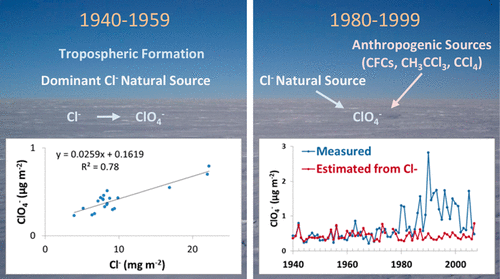当前位置:
X-MOL 学术
›
Environ. Sci. Technol.
›
论文详情
Our official English website, www.x-mol.net, welcomes your
feedback! (Note: you will need to create a separate account there.)
Anthropogenic Perchlorate Increases since 1980 in the Canadian High Arctic
Environmental Science & Technology ( IF 10.8 ) Pub Date : 2018-01-10 00:00:00 , DOI: 10.1021/acs.est.7b03132 Vasile I. Furdui 1 , Jiancheng Zheng 2, 3 , Andreea Furdui 1
Environmental Science & Technology ( IF 10.8 ) Pub Date : 2018-01-10 00:00:00 , DOI: 10.1021/acs.est.7b03132 Vasile I. Furdui 1 , Jiancheng Zheng 2, 3 , Andreea Furdui 1
Affiliation

|
An ice core of 15.5 m retrieved from Agassiz Ice Cap (Nunavut, Canada) in April 2009 was analyzed for perchlorate to obtain a temporal trend in the recent decades and to better understand the factors affecting High Arctic deposition. The continuous record dated from 1936 to 2007, covers the periods prior to and during the major atmospheric releases of organic chlorine species that affected the stratospheric ozone levels. Concentrations and yearly fluxes of perchlorate and chloride showed a significant correlation for the 1940–1959 period, suggesting a predominant tropospheric formation by lightning. While concentration of chloride remained unchanged from 1940s until 2009, elevated levels of perchlorate were observed after 1979. A lack of significant increases in either sulfate or chloride between 1980 and 2001 suggests that the effect of volcanic activities on the perchlorate at the study site during this period could be insignificant. Therefore, the elevated perchlorate in the ice could most likely be attributed to anthropogenic activities that influenced perchlorate sources and formation mechanisms after 1979. Our results show that anthropogenic contribution could be responsible for 66% of perchlorate found in the ice. Although with some differences in trends and amounts, deposition rate found in this study is similar to those observed at Devon Island (Nunavut, Canada), Eclipse Icefield (Yukon, Canada) and Summit Station (Greenland). Methyl chloroform, a chlorinated solvent largely used after 1976, peaked in the atmosphere in 1990 and has a much shorter atmospheric life than chlorofluorocarbons (CFCs). This study proposes methyl chloroform (CH3CCl3) as the significant anthropogenic source of perchlorate in the Canadian High Arctic between 1980 and 2000, with HCFC-141b (Cl2FC–CH3), a relatively short-lived CFC probably responsible for a slower decrease in perchlorate deposition after the late 1990s. The presence of aerosols in the stratosphere appears to suppress perchlorate production after 1974. As both methyl chloroform and HCFC-141b had no new significant emissions after 2003, deposition of perchlorate in High Arctic is expected to remain at pre-1980 levels.
中文翻译:

自1980年以来,加拿大高北极地区的人为高氯酸盐含量增加
2009年4月从Agassiz Ice Cap(加拿大努纳武特)取回的15.5 m冰芯进行了高氯酸盐分析,以获取近几十年来的时间趋势,并更好地了解影响高北极沉积的因素。1936年至2007年的连续记录涵盖了影响平流层臭氧水平的有机氯物种在主要大气释放之前和期间的时期。在1940-1959年期间,高氯酸盐和氯化物的浓度和年通量显示出显着的相关性,表明闪电主要形成了对流层。尽管从1940年代到2009年氯化物的浓度保持不变,但1979年以后观察到高氯酸盐的含量升高。在1980年至2001年之间,硫酸盐或氯化物的缺乏显着增加表明,在此期间,火山活动对研究地点的高氯酸盐的影响可能微不足道。因此,冰中高氯酸盐的增加很可能归因于1979年以后人为活动影响了高氯酸盐的来源和形成机制。我们的研究结果表明,人为贡献可能占冰中高氯酸盐的66%。尽管在趋势和数量上存在一定差异,但本研究发现的沉积速率与在德文岛(加拿大努纳武特),日蚀冰原(加拿大尤肯)和萨米特站(格陵兰)观察到的沉积速率相似。甲基氯仿,一种在1976年后大量使用的氯化溶剂,1990年在大气中达到峰值,比氯氟烃(CFC)的大气寿命短得多。这项研究提出了甲基氯仿(CH3 CCl 3)是1980年至2000年之间加拿大高北极地区人为高氯酸盐的重要来源,HCFC-141b(Cl 2 FC–CH 3)是一种寿命相对较短的CFC,可能导致高氯酸盐沉积后的缓慢下降1990年代后期。1974年后,平流层中气溶胶的存在似乎抑制了高氯酸盐的产生。由于2003年以后甲基氯仿和HCFC-141b都没有新的显着排放,因此高北极地区的高氯酸盐沉积预计将保持在1980年前的水平。
更新日期:2018-01-10
中文翻译:

自1980年以来,加拿大高北极地区的人为高氯酸盐含量增加
2009年4月从Agassiz Ice Cap(加拿大努纳武特)取回的15.5 m冰芯进行了高氯酸盐分析,以获取近几十年来的时间趋势,并更好地了解影响高北极沉积的因素。1936年至2007年的连续记录涵盖了影响平流层臭氧水平的有机氯物种在主要大气释放之前和期间的时期。在1940-1959年期间,高氯酸盐和氯化物的浓度和年通量显示出显着的相关性,表明闪电主要形成了对流层。尽管从1940年代到2009年氯化物的浓度保持不变,但1979年以后观察到高氯酸盐的含量升高。在1980年至2001年之间,硫酸盐或氯化物的缺乏显着增加表明,在此期间,火山活动对研究地点的高氯酸盐的影响可能微不足道。因此,冰中高氯酸盐的增加很可能归因于1979年以后人为活动影响了高氯酸盐的来源和形成机制。我们的研究结果表明,人为贡献可能占冰中高氯酸盐的66%。尽管在趋势和数量上存在一定差异,但本研究发现的沉积速率与在德文岛(加拿大努纳武特),日蚀冰原(加拿大尤肯)和萨米特站(格陵兰)观察到的沉积速率相似。甲基氯仿,一种在1976年后大量使用的氯化溶剂,1990年在大气中达到峰值,比氯氟烃(CFC)的大气寿命短得多。这项研究提出了甲基氯仿(CH3 CCl 3)是1980年至2000年之间加拿大高北极地区人为高氯酸盐的重要来源,HCFC-141b(Cl 2 FC–CH 3)是一种寿命相对较短的CFC,可能导致高氯酸盐沉积后的缓慢下降1990年代后期。1974年后,平流层中气溶胶的存在似乎抑制了高氯酸盐的产生。由于2003年以后甲基氯仿和HCFC-141b都没有新的显着排放,因此高北极地区的高氯酸盐沉积预计将保持在1980年前的水平。











































 京公网安备 11010802027423号
京公网安备 11010802027423号